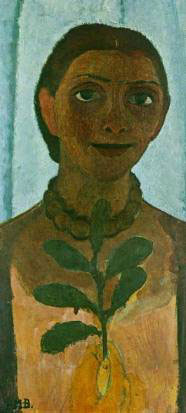 xxx
xxx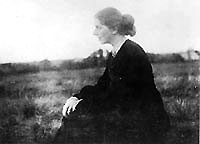 xxx
xxx
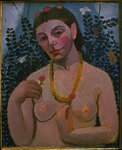
the art of Paula Modersohn-Becker (Paula, center)
In
1900, Rainer
Rilke met Paula
Becker in
the rural artist colony of Worpswede, Germany
and
immediately fell in love
with her strength of personality
and artistic talent.
They were
both 24 years old.
Though Paula was also drawn to Rilke,
she was already
betrothed to German
painter Otto
Modersohn. They were engaged just weeks after
she met Rilke
who,
upon discovering
their relationship,
rebounded to Paula's best friend, sculptress Clara
Westhoff. The two artist couples
-- self-named "The Family" for the strong artistic bonds
they formed -- both married in the Spring of 1901.
The
following
December, the
Rilkes gave birth to a daughter, Ruth
Rilke. The
Modersohns, however,
remained childless until late
1907.
Rainer Maria
Rilke found his new life as a father and family man
harshly incompatible with his artistic needs. Six
months
after Ruth was born, he
and Clara
agreed to live apart. Clara's parents also
agreed to take care of Ruth so the two of them
could
pursue their art. Their little family experienced
brief reunions
throughout their lives
but never remained
together.
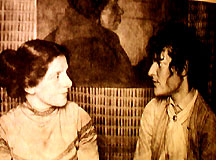

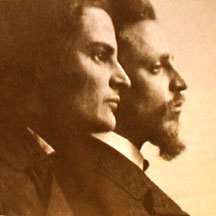
(left)
Best friends, Paula Becker and Clara Westhoff (1900)
(center) Paul Modersohn-Becker and Otto Modersohn
(1902)
(right) Clara Westhoff-Rilke and Rainer Maria Rilke
(1904)
Over
the next few years Rainer Rilke and Paula Modersohn-Becker
corresponded in letters.
During the
spring and
summer of 1906 they
attended numerous cultural events together in
Paris
when
Paula lived apart from Otto to focus
exclusively
on her art.
At the time Paula
also had no intention
of returning to Otto. During this period Paula
painted
numerous
works, among them her famous portrait
of Rilke, a now frequent visitor to her studio.
Though
Paula didn't
always agree with Rilke's "Art vs.
Life" arguments, both showed a
respect
common
between equals and "lovers in spirit".
Rilke's
argument was that
certain
women artists were never
meant to bear children but rather, to gestate
and
birth
the
lifelong fruition of their Art. Though Paula
wanted children,
she did
not want
them yet. She wanted
to create more art
first. However,
in the
autumn of
1906, Otto visited Paula in Paris pleading with her
to
return
with him to rural Germany.
During this meeting
Rilke was
nowhere
to be seen.
After what must have
been a difficult
decision,
Paula joined Otto
back
to Worpswede, Germany.
This was also
the last time Rilke would see Paula.
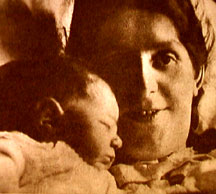
Mathilde
and Paula, November 1907
(days before Paula's death)
Paula
and Otto conceived around her 31st birthday in February
of 1907.
Nine months later on November 20th,
eighteen
days after the birth of
their
daughter
Mathilde, Paula suddenly died
of post-natal complications;
an
embolism
in her leg
erupted in thrombosis and cardiac arrest. While standing
fully conscious
in her
own bedroom,
she spoke her
final words,"what a
shame",
and collapsed. With
almost 600 paintings
and over
a thousand sketches,
Paula's sudden and tragic death
came at
the peak of her artistic
development.
At the time, Rilke was busy with a
successful
European book tour and remained in
denial
of Paula's death until almost
a year
later when he
paid a visit
to
the Louvre in Paris.
Here an 18th
dynasty
Egyptian
sandstone bust
startled Rilke's memory of an earlier
bust
Clara
sculpted
of Paula. The floodgates opened wide.
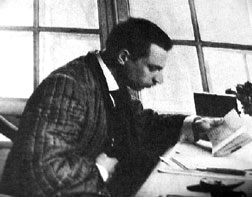
"An
unexpected, powerful current of work had suddenly
surfaced." R. Rilke
In
the days and nights that followed -- October 31 through
November 2, 1908 -- Rilke wrote
"Requiem For a Friend",
his
lyrical lament and tribute to Paula, alone in a room
at the Hotel
Biron
in Paris.
Though
his
"Requiem" was published
a few months
later (1909), the trauma of
Paula's
death haunted
Rilke for most of his remaining years. Writing his
"Requiem"
was a
major breakthrough in his
artistic process that paved the way for what many
consider to
be his most significant works:
"The
Notebooks of Malte Laurids Brigge" (1910), "The
Duino
Elegies" (1912-1922) and "The Sonnets
to Orpheus" (1923). In
September of 1926 Rilke was
diagnosed
with advanced
leukemia. In
the following months his condition rapidly
declined
and on December
29, 1926, Rilke passed away. He was laid to rest near the small town of
Raron Switzerland
in a simple grave with a tombstone inscribed with
the epitaph
he had written for himself fourteen months
earlier:
Rose,
oh pure contradiction, desire,
To be no one's sleep under so many
Lids.
Sources
"Dear Friend" by Eric
Torgersen
"A Ringing Glass" by Donald Prater
"Life of a Poet" by Ralph Freedman
"Letters of Rainer Maria Rilke: 1892-1910"

Rilke
in 1926 (click photo for Rilke's bio)
Rainer Maria Rilke (1875-1926)
"Do
not be bewildered by the surfaces;
in the depths, all becomes law."
"Requiem For a Friend"
The text in its entirety (Stephen Mitchell, translator)
"ON
LOVE & OTHER DIFFICULTIES"
from "Letters to a Young Poet"
BACK TO: "THE GREATER CIRCULATION"